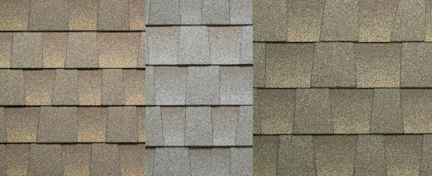Reflective granules save energy and the environment
 An increasing number of consumers are warming up to the environmental and money-saving benefits of cool roofing asphalt shingles.
An increasing number of consumers are warming up to the environmental and money-saving benefits of cool roofing asphalt shingles.
Also called “highly reflective roofs,” cool roofs reflect and emit the sun’s heat back to the sky rather than transferring it to the building below, according to the Asphalt Roofing Manufacturers Association (ARMA). The “coolness” of the roof is measured by two properties: solar reflectance (SR or reflectivity), or the fraction of solar energy that is reflected by the roof, and thermal emittance, or the relative ability of the roof surface to radiate absorbed heat—or a combination of the two called the Solar Reflective Index (SRI.)
In the past, it was only possible to produce shingles that meet ENERGY STAR and Cool Roof Rating Council standards for reflectivity and emissivity in white. However, thanks to recent advances in cool roofing technology, cool roofs made of asphalt shingles come in a variety of colors.
GAF, North America’s largest manufacturer of commercial and residential roofing, was the first to produce an energy-efficient asphalt shingle available in rich colors, called the Timberline? Cool Series. The shingles use specially designed granules that have greater reflectance than traditional shingles, minimizing the transfer of heat to the space below.
“The response to our cool roof products is growing as “green” becomes more a part of the vocabulary of all of our customers,” said Nkechi Okwumabua, marketing project manager at GAF.
Cool roof requirements also are appearing in building energy codes and green building programs across the nation, according to the Cool Roof Rating Council (CRRC). The CRRC is a non-profit educational organization that maintains a credible, third-party rating system to measure and label the radiative properties of roofing materials.
A “cooler” choice
Asphalt is not used differently when producing cool roof shingles, according to manufacturers.
“Owens Corning Duration” Premium COOL Shingles are constructed in the same way our other laminates are made; what makes them “cool” is the use of special reflective granules,” said Sue Burkett, marketing leader for Owens Corning Roofing & Asphalt LLC. “We do not use a different type of asphalt in their production. The granules used in cool roof shingles are specially engineered and constructed using infrared reflectant coatings. These highly reflective granules bounce back the sun’s rays—helping to keep the roof cooler, which can result in lower energy usage and reduced wear and tear on air conditioning systems.”
According to ARMA, a cool roof has several benefits including increased energy efficiency, reduced energy bills, longer roof life, improved comfort, reduced capital cost and reduced “heat island effect.”
“There are many factors that affect how well cool shingles save energy,” said Burkett, who is also a member of ARMA’s Communications, Marketing & Education Committee. “Cool shingles are most effective in hot, sunny climates where there are often heating and air conditioning ducts in the attic and lower levels of the ceiling insulation. In colder climates, the savings are reduced.”
Studies also show that cool roofs directly reduce greenhouse gas emissions by conserving electricity for air conditioning, therefore emitting less CO2 from power plants, according to the CRRC. The CRRC cites a Lawrence Berkeley National Laboratory study that found that world-wide reflective roofing will produce a global cooling effect equivalent to offsetting 24 gigatons of CO2 over the lifetime of the roofs.
ARMA suggests a “Whole Building Envelope Approach” as the best option for designing and optimizing performance-based, proven and cost effective commercial and residential buildings. To make a steep-sloped, asphaltic roof more energy efficient ARMA recommends asphalt shingles with cool granule technology, proper attic ventilation, added insulation or a combination of these. Measures that make low-slope residential asphalt roofs more energy efficient include factory surfacing with reflective performance (adding granulated cap sheets); increased insulation; reflective coatings over some non-reflective, low slope membranes; or vegetative or garden roofs.
In cooler climates, the benefits of reflective roofing as a sound energy-efficient choice are specific to the particular region and its climate, according to ARMA. There is much discussion of cool roofing?s effects on the “heat island” phenomenon.
“According to studies by Dr. Arthur Rosenfeld of the Alliance to Save Energy, it can be five to seven degrees warmer in the city on a typical day,” said Martin Grohman, director of sustainability at GAF. “Dr. Rosenfeld’s studies show compelling results indicating that cool roofs can help reduce this urban heat island effect.”
In addition to energy savings, because the solar-reflecting granules help keep the shingles cooler, they can also help slow asphalt aging and extend the life of the roof, Burkett said.
Stimulus and savings
Energy savings and environmental concerns aren’t the only reasons more consumers opt for asphalt shingles with cool granule technology. Interest has increased along with the American Reinvestment & Recovery Act of 2009-2010 stimulus bill tax credits.
Consumers who install asphalt roofs with appropriate cooling granules that also meet ENERGY STAR requirements may be eligible for 10 percent of the cost of the roof, up to $500. The ENERGY STAR program is a joint venture of the U.S. Environmental Protection Agency (EPA) and the U.S. Department of Energy.
“According to the ENERGY STAR’s website, the program helped Americans save enough energy in 2009 to avoid greenhouse gas emissions equal to those from 30 million cars, while saving nearly $17 billion on their utility bills,” said Andy Lodge, manager for technical and industry affairs for IKO Industries, which operates more than 20 roofing products manufacturing plants globally. “Roofing is a large part of those savings, and as more roofs are covered by reflective shingles, the savings will continue to climb.”
For more information about cool roofing, visit the Asphalt Roofing Manufacturers Association at www.asphaltroofing.org, or the Cool Roof Rating Council at www.coolroofs.org.













